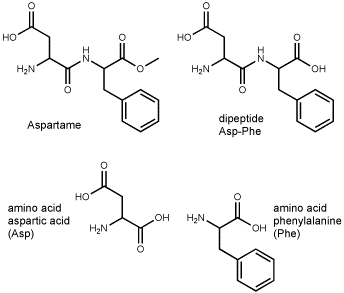
180 times as sweet as sugar (sucrose).
 |
As you can see above, the sugar substitute aspartame, found in Equal, Nutrasweet, and many diet soft drinks and chewing gums, is not a sugar at all (see also neotame). It is, in fact, a dipeptide (two amino acids joined together, as in a protein). But it's is a very slightly modified dipeptide. Can you spot the difference?
180 times as sweet as sugar (sucrose). |
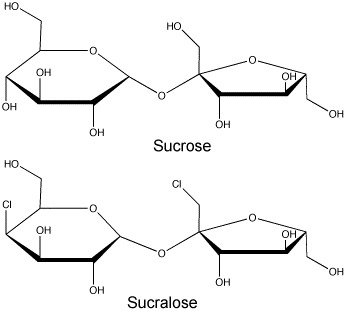 |
In this case, the artificial sweetener sucralose looks very similar to the natural sugar sucrose. Sucralose is in some soft drinks and is marketed as an alternative to aspartame.
600 times as sweet as sugar. |
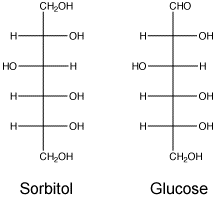 |
The naturally occuring sweetener sorbitol looks very similar to the natural sugar glucose. Sucralose is found in sugar-free chewing gum, ice cream, and in some soft drinks.
Sorbitol (and xylitol) cannot be used by mouth bacteria to produce tooth-damaging acids and thus are preferred in sugarless gum. There is some thought that chewing such gum may actually help prevent cavities. How would you make sorbitol out of glucose? |
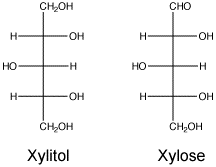 |
The naturally occuring sweetener xylitol looks very similar to the natural sugar xylose. Xylitol is found naturally in the fibers of some fruits (berries) and vegetables (corn fibre, oats, and mushrooms). Xylose is also known as wood sugar and occurs in plant fibers as well. Xylitol is a problem for dogs in that ingestion of xylitol can lead to a hypoglycemic response. In humans, it has a mild laxative effect, because it is not completely broken down during digestion. |
 |
As you can see at left, the sugar substitute acesulfame, found in the sugar substitutes Sunett and Sweet One, and in some diet soft drinks, is not a sugar at all, nor is it a dipeptide. Like saccharin, it has a partially bitter after taste, so is often mixed with other artificial sweeteners.
180-200 times as sweet as sugar. |
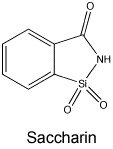 |
As you can see at left, the sugar substitute saccharin, the oldest of the sugar substitutes, is also not a sugar.
300 times as sweet as sugar (sucrose). |
Cyclamate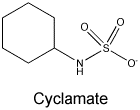 |
As you can see at left, the sugar substitute cyclamate, another older sugar substitute, is also not a sugar. Cyclamate was the first of the artificial sweetener controversies: lab rats, fed large amounts of cyclamates, were reported to develop bladder cancer, and the FDA then banned the use of cyclamates. Since that time, studies have shown the earlier studies to be deficient and though the FDA now stated that a review of the evidence does not implicate cyclamate in increased cancer in rats, cyclamate remains banned for use in the U.S. Cyclamate is in use in Canada and more than 50 other countries.
30-50 times as sweet as sugar (sucrose). |